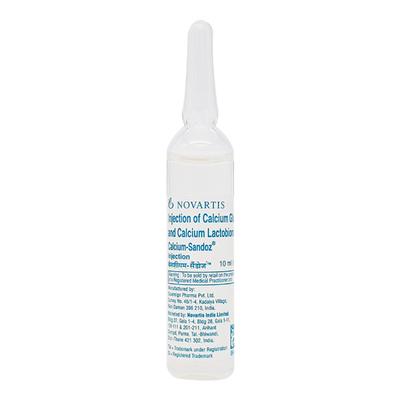

Netmeds First Membership
Quick Links
Introduction About CALCIUM SANDOZ INJECTION
CALCIUM SANDOZ INJECTIONcontains a combination of Calcium gluconate and Calcium lactobionate which belongs to the group of medicine called Minerals. It is used to manage acute symptomatic hypocalcemia (calcium deficiency). Calcium deficiency can be due to a variety of factors such as poor calcium intake in childhood, decreased calcium absorption and dietary tolerance, hormonal changes, and genetic factors.
There are no symptoms in the beginning, but as the condition progresses, symptoms such as confusion, memory loss, muscle spasms, cramps, hallucinations, an easy bone fracture, tingling and numbness of body parts, and depression may appear.
Before receiving CALCIUM SANDOZ INJECTION, inform your doctor if you have kidney, heart, or parathyroid gland problems, cancer, or hypercalcemia (increased calcium levels). Inform your doctor if you are pregnant or breastfeeding before receiving CALCIUM SANDOZ INJECTION. CALCIUM SANDOZ INJECTION is not recommended for use in children below 1 month of age receiving ceftriaxone.
The most common side effects of receiving CALCIUM SANDOZ INJECTION are constipation and injection site reactions like pain, swelling, and redness. Contact your doctor if symptoms worsen.
Uses Of CALCIUM SANDOZ INJECTION
- Manage calcium deficiency
How CALCIUM SANDOZ INJECTION Works
CALCIUM SANDOZ INJECTION works by strengthening the bones where calcium gluconate dissociates into ionised calcium in the blood, increasing serum ionised calcium levels. Ionized calcium and gluconate are normal constituents of body fluids, and calcium lactobionate works by replenishing the stores of calcium in the body.
How to use CALCIUM SANDOZ INJECTION
CALCIUM SANDOZ INJECTION will be given to you only by a doctor or a nurse into a vein as an intravenous infusion. Your doctor will determine the right dose and duration depending upon your age, body weight, and disease condition.
Side Effects Of CALCIUM SANDOZ INJECTION
Common
- warmth, tingling, or a heavy feeling
- stomach upset, flatulence
- constipation
- injection site reactions like pain, swelling and redness
Rare
Stop receiving CALCIUM SANDOZ INJECTION and contact your doctor immediately if you experience any of the following side effects:
- little or no urination
- swelling, rapid weight gain
- a light-headed feeling
- slow or irregular heartbeats
- high levels of calcium in your blood (nausea, vomiting, constipation, increased thirst or urination, muscle weakness, bone pain, confusion, lack of energy)
How To Manage Side Effects
Constipation
Eat plenty of fiber-rich foods such as fresh fruits, vegetables, and cereals and drink plenty of water. Exercise more regularly. If the symptom doesn’t improve, consult your doctor.
Indigestion
Eat smaller and more frequent meals. Exercise regularly. If the symptom doesn’t improve, consult your doctor.
Warning & Precautions
Pregnancy
Consult your doctorInform your doctor if you are pregnant or planning to become pregnant as there in limited information on the safety of receiving CALCIUM SANDOZ INJECTION. Consult your doctor before receiving it, it will be given to you after calculating the risk and benefit ratio.
Breastfeeding
Consult your doctorInform your doctor if you are breastfeeding before receiving CALCIUM SANDOZ INJECTIONas it is not known if it is excreted in breast milk. Consult your doctor before receiving it, it will be given to you after calculating the risk and benefit ratio.
Driving and Using Machines
Use with CautionIt is not known if CALCIUM SANDOZ INJECTION affects the ability to drive or use machines, do not drive or use machines in case you experience unusual symptoms.
Kidney
Consult your doctorCALCIUM SANDOZ INJECTION should be used with caution in patients with kidney disease, and kidney stones. The dose will be adjusted by your doctor and regular serum calcium levels will be monitored. Consult your doctor before receiving it.
Allergy
ContraindicatedInform your doctor before receiving CALCIUM SANDOZ INJECTION if you are allergic to Calcium gluconate or Calcium lactobionate.
Heart Disease
Use with CautionCALCIUM SANDOZ INJECTION should be used with caution in patients with heart problems. Consult your doctor before receiving it.
Use In Pediatrics
Consult your doctorCALCIUM SANDOZ INJECTIONis not recommended for use in children below 28 days old receiving ceftriaxone. Consult your doctor before receiving it.
Use In Geriatrics
Consult your doctorThe doctor will adjust the dose for patients above 65 years of age receiving CALCIUM SANDOZ INJECTION, depending on the disease condition. Consult your doctor before receiving it.
Others
CALCIUM SANDOZ INJECTION is not recommended for use if you:
- have hypercalcemia (high calcium levels)
Before receiving CALCIUM SANDOZ INJECTION, inform your doctor if you:
- have parathyroid gland problems
- have cancer
Interactions
A. Drug-Drug interactions:
Before receiving CALCIUM SANDOZ INJECTION, inform your doctor if you are taking any of the following medicine:
- ceftriaxone, minocycline (antibiotic to manage bacterial infection)
- fluids containing bicarbonate or phosphate
- cardiac glycosides like digoxin (to manage heart failure and irregular heartbeats)
- calcium channel blockers (Ex. amlodipine, diltiazem, to lower blood pressure)
- vitamin D, vitamin A
- thiazide diuretics (Ex. chlorothiazide, indapamide, to increase urine flow)
- estrogen
- calcipotriene (to manage psoriasis)
- teriparatide (to manage osteoporosis)
- baloxavir marboxil (to manage influenza)
Overdosage:
CALCIUM SANDOZ INJECTION will be administered to you only by a doctor or a nurse in a hospital, and so it is unlikely to receive an overdose. However, consult your doctor or nurse if you experience any unusual symptoms of hypercalcemia (hallucinations, disorientation, hypotonicity, seizures, and coma)
Synopsis
| Drug | : | Calcium gluconate, Calcium lactobionate |
| Pharmacological Category | : | Minerals |
| Therapeutic Indication | : | Calcium deficiency |
| Dosage Forms | : | Injection |
More Information
- Keep CALCIUM SANDOZ INJECTION out of reach of children
- Store at 20-25°C
FAQs About CALCIUM SANDOZ INJECTION
Q: What is CALCIUM SANDOZ INJECTION used for?
A: CALCIUM SANDOZ INJECTION is used to manage acute symptomatic hypocalcemia (calcium deficiency). Calcium deficiency can be due to a variety of factors, such as poor calcium intake in childhood, decreased calcium absorption and dietary tolerance, hormonal changes, and genetic factors.
Q: Can pregnant women receive CALCIUM SANDOZ INJECTION?
A: Inform your doctor if you are pregnant or planning to become pregnant, as there is limited information on the safety of receiving CALCIUM SANDOZ INJECTION. Consult your doctor before receiving it; it will be given to you after calculating the risk-to-benefit ratio.
Q: How does CALCIUM SANDOZ INJECTION work?
A: CALCIUM SANDOZ INJECTION works by strengthening the bones, where calcium gluconate dissociates into ionised calcium in the blood, which increases serum ionised calcium levels. Ionized calcium and gluconate are normal constituents of body fluids, and calcium lactobionate works by replenishing the stores of calcium in the body.
Q: Can children receive CALCIUM SANDOZ INJECTION?
A: CALCIUM SANDOZ INJECTION is not recommended for use in children below 28 days old receiving ceftriaxone as it can have fatal outcomes. Consult your doctor before receiving it.
Q: Can patients with kidney problems receive CALCIUM SANDOZ INJECTION?
A: CALCIUM SANDOZ INJECTION should be used with caution in patients with kidney disease or kidney stones. The dose will be adjusted by your doctor, and regular serum calcium levels will be monitored. Consult your doctor before receiving it.
References
1. KD Tripathi. Hormones and Drugs Affecting Calcium Balance. Essentials of medical pharmacology. Eighth Edition. 2019. Page –362.
2. Anumita Chakraborty; Ahmet S. Can. Calcium gluconate. [Revised in January 2022] [Accessed on 30th June 2022] https://www.ncbi.nlm.nih.gov/books/NBK557463/
3. S.Sáez-Orviz, P.Camilleri, I.Marcet, M.Rendueles, M.Díaz. Microencapsulation of calcium lactobionate for protection from microorganisms in solid-phase food. [Revised in October 2019] [Accessed on 30th June 2022] https://www.sciencedirect.com/science/article/abs/pii/S1369703X19302141
4. Fresenius kabi. U.S. Food & Drug Administration. [Revised in June 2017] [Accessed on 30th June 2022] https://www.accessdata.fda.gov/drugsatfda_docs/label/2017/208418s000lbl.pdf
5. Calcium gluconate. Drugs.com [Revised in June 2021] [Accessed on 30th June 2022] https://www.drugs.com/calcium-gluconate.html
6. Calcium lactobionate. Pubchem [Accessed on 30th June 2022] https://pubchem.ncbi.nlm.nih.gov/compound/Calcium-lactobionate
7. Calcium gluconate+calcium lactobionate. Healthline. [Revised in July 2019] [Accessed on 30th June 2022] https://www.healthline.com/health/calcium-deficiency-disease








